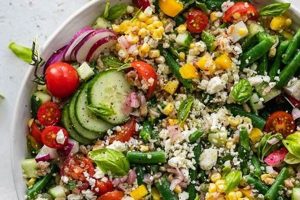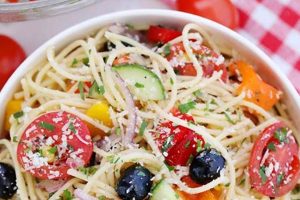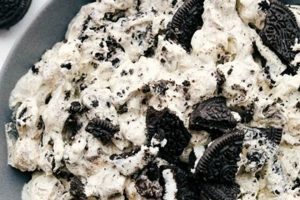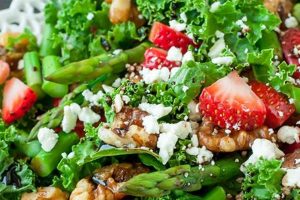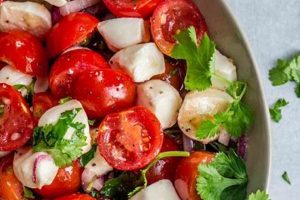A structured set of instructions for preparing a specific dish, in this case, a vibrant Southeast Asian salad featuring shredded green papaya, often combined with ingredients such as tomatoes, chilies, garlic, fish sauce, lime juice, and peanuts. Variations exist across regions, incorporating ingredients like dried shrimp, crab, or long beans, leading to a diverse range of flavor profiles.
Documentation of these culinary instructions preserves cultural heritage, allowing for consistent recreation of cherished flavors and facilitating the sharing of culinary traditions across generations and geographical boundaries. The structured approach ensures consistent results, offering a foundation for both novice and experienced cooks to explore and appreciate this globally popular dish. Moreover, understanding the components and their interactions allows for creative adaptation and personalized variations.
This exploration will delve into the core elements of this culinary process, examining the diverse regional adaptations, exploring the nutritional benefits of the key ingredients, and providing practical guidance for successful preparation and enjoyment.
Tips for Papaya Salad Preparation
Achieving optimal flavor and texture requires attention to detail throughout the preparation process. The following tips offer guidance for a successful outcome.
Tip 1: Selecting the Papaya: Choose firm, unripe papayas with green skin. Avoid those with soft spots or a yellowish tinge, as they will be overly sweet and lack the desired crispness.
Tip 2: Balancing Flavors: The hallmark of this dish lies in the harmonious balance of sweet, sour, salty, spicy, and umami. Adjust the quantities of lime juice, fish sauce, sugar, and chilies to achieve the desired flavor profile.
Tip 3: Using a Mortar and Pestle: Traditional preparation involves using a mortar and pestle to bruise the ingredients, releasing their aromas and creating a complex flavor profile. While a food processor can be used, it may result in a less nuanced final product.
Tip 4: Adding Ingredients in Stages: Start by pounding the garlic and chilies, followed by the tomatoes and green beans (if using). Add the shredded papaya last to avoid over-bruising.
Tip 5: Adjusting Texture: The texture should be crisp and refreshing. Avoid over-pounding the papaya, which can result in a mushy consistency.
Tip 6: Serving Immediately: This salad is best enjoyed immediately after preparation, as the flavors meld and the papaya maintains its crisp texture.
Tip 7: Garnish and Presentation: Garnishing with roasted peanuts, fresh herbs, and lime wedges enhances the visual appeal and adds another layer of flavor and texture.
Adherence to these guidelines ensures a flavorful and texturally satisfying experience, allowing one to appreciate the nuanced complexities of this popular dish.
By understanding the principles and techniques outlined above, individuals can confidently embark on the culinary journey of creating this vibrant and refreshing salad.
1. Ingredients
The quality and combination of ingredients directly influence the final flavor profile of papaya salad. Careful selection and preparation are crucial for achieving the desired balance of sweet, sour, salty, spicy, and umami notes. Understanding the role of each component contributes to a successful outcome.
- Green Papaya
The foundation of the dish, unripe green papaya provides a crisp texture and subtly sweet flavor. Its firmness allows it to withstand pounding without becoming mushy. Selecting firm, unblemished papayas is essential for optimal texture and taste.
- Chillies
The level of spiciness is a defining characteristic, commonly achieved through the use of Thai chilies. Bird’s eye chilies contribute intense heat, while other varieties offer varying degrees of pungency. The quantity of chilies used can be adjusted to suit individual preferences.
- Lime Juice
Freshly squeezed lime juice provides the essential sour element, balancing the sweetness of the papaya and other ingredients. Its acidity also contributes to the bright, refreshing nature of the salad. The balance of sourness is crucial for overall flavor harmony.
- Fish Sauce
Fish sauce delivers a savory, umami depth and saltiness, complementing the other flavor components. Its distinctive aroma and taste are integral to the authentic flavor profile. The quality of fish sauce significantly impacts the final result.
These core ingredients form the basis of most papaya salad recipes. Additional components, such as tomatoes, garlic, peanuts, dried shrimp, or long beans, can introduce further complexity and textural variation, contributing to the diverse regional interpretations of this vibrant dish.
2. Preparation Method
The preparation method of papaya salad significantly influences its final texture and flavor profile. While variations exist across regions, the fundamental techniques remain consistent, emphasizing the importance of balancing ingredients and achieving the desired level of bruising and pounding. Understanding these techniques is essential for creating an authentic and flavorful dish.
- Pounding with Mortar and Pestle
Traditional preparation involves using a mortar and pestle to bruise and combine the ingredients. This process releases the flavors of the chilies, garlic, and other aromatics, while also tenderizing the papaya and other vegetables. The rhythmic pounding action creates a unique texture and allows the flavors to meld harmoniously. The degree of pounding influences the final texture, ranging from crisp and crunchy to slightly softened.
- Balancing Ingredients
The order in which ingredients are added to the mortar is crucial. Typically, harder ingredients like garlic and chilies are pounded first, followed by softer components like tomatoes. The shredded papaya is added last to avoid over-bruising. This staged approach ensures even distribution of flavors and maintains the desired texture of each ingredient.
- Adjusting Flavors
Throughout the pounding process, the balance of flavors is continuously assessed and adjusted. Lime juice, fish sauce, and sugar are added incrementally, allowing for careful calibration of the sweet, sour, salty, and spicy elements. This iterative process ensures a harmonious and well-balanced final product tailored to individual preferences.
- Incorporating Regional Variations
While the core techniques remain consistent, regional variations introduce unique elements to the preparation process. For example, some recipes may call for grilling certain ingredients before pounding, or incorporating specific regional ingredients like fermented fish paste or dried shrimp. These adaptations contribute to the diversity of papaya salad preparations found across Southeast Asia.
Mastery of these preparation techniques is fundamental to achieving the desired flavor and textural complexity in papaya salad. From the rhythmic pounding to the careful balancing of ingredients, each step contributes to the creation of a vibrant and refreshing dish that showcases the harmonious interplay of Southeast Asian flavors.
3. Flavor Balance
Flavor balance is paramount in papaya salad, distinguishing it from other salads. The dish thrives on a dynamic interplay of contrasting yet complementary tastes: the sourness of lime, the saltiness of fish sauce, the sweetness of palm sugar, the spiciness of chilies, and the umami notes from ingredients like fermented fish paste (padaek) or dried shrimp. A successful recipe hinges on the harmonious integration of these elements. An overly sour salad can be jarring, while excessive sweetness diminishes the complexity. Similarly, overpowering spiciness obscures the other nuances. The objective is not to neutralize these tastes, but rather to orchestrate them into a unified, vibrant whole.
Consider the role of lime juice. Its acidity not only provides a refreshing tang but also acts as a crucial counterpoint to the sweetness of the papaya and the saltiness of the fish sauce. The lime’s sharpness cuts through the richness of the other ingredients, preventing the salad from becoming cloying. Similarly, the subtle sweetness of palm sugar tempers the aggressive heat of the chilies and the pungent fish sauce, creating a more rounded flavor profile. These interactions demonstrate the interconnectedness of each element and the importance of precise measurements in achieving the desired balance. For example, in the Isaan region of Thailand, where papaya salad originates, the balance often leans towards a higher level of spiciness and funkiness from fermented fish sauce, reflecting local preferences. In contrast, some variations in Laos might incorporate more herbs and a milder chili profile.
Understanding flavor balance empowers culinary exploration and adaptation. Recipes serve as guidelines, but palates vary. Adjusting the proportions of ingredients allows for personalization. Someone seeking a milder salad might reduce the chilies and increase the sugar. Conversely, those who prefer a more pungent experience can amplify the fish sauce or incorporate more potent chili varieties. This flexibility highlights the dynamic nature of papaya salad and the opportunity for individual expression within its established flavor framework. Ultimately, achieving flavor balance elevates the dish from a simple combination of ingredients to a complex and satisfying culinary experience.
4. Texture
Texture plays a crucial role in the overall sensory experience of papaya salad. The interplay of crispness, firmness, and occasional chewiness contributes significantly to the dish’s appeal. Achieving the desired textural complexity relies heavily on the selection of ingredients, the preparation techniques employed, and the careful balance maintained throughout the process. A proper understanding of these factors is essential for crafting a successful and satisfying papaya salad.
- Papaya Firmness
The firmness of the green papaya is paramount. An unripe, firm papaya provides the desired crispness and resistance to the pounding process. Overly ripe papayas result in a mushy, less desirable texture. The firmness contributes to the refreshing and invigorating mouthfeel characteristic of a well-made papaya salad. This crispness contrasts with other elements, creating a dynamic textural experience.
- Pounding Technique
The pounding technique employed significantly influences the final texture. Skillful pounding using a mortar and pestle bruises the papaya and other ingredients just enough to release their flavors while maintaining a pleasant crispness. Over-pounding can lead to a mushy texture, diminishing the overall enjoyment. The rhythmic pounding action creates subtle variations in texture, contributing to the dish’s complexity. This technique allows for control over the degree of bruising and the resulting texture.
- Ingredient Incorporation
The order in which ingredients are incorporated also affects the texture. Harder ingredients, such as garlic and chilies, are typically pounded first, followed by progressively softer components like tomatoes and green beans. The shredded papaya is usually added last to avoid over-pounding and maintain its crisp texture. This strategic approach preserves the distinct textures of each ingredient, contributing to a layered and satisfying mouthfeel.
- Textural Contrasts
The interplay of textures from various ingredients contributes to the overall sensory experience. The crispness of the papaya contrasts with the crunch of peanuts, the chewiness of dried shrimp (if used), and the juiciness of tomatoes. These textural contrasts create a dynamic and engaging mouthfeel, enhancing the complexity and enjoyment of the dish. Balancing these contrasting textures is key to a well-rounded papaya salad.
The final texture of papaya salad is a crucial element of its appeal. The careful consideration of papaya firmness, pounding technique, ingredient incorporation, and the interplay of textural contrasts ensures a harmonious balance that elevates the dish beyond its individual components. This textural complexity contributes significantly to the overall sensory experience, creating a vibrant and refreshing dish that is both flavorful and satisfying.
5. Regional Variations
Regional variations in papaya salad recipes reflect diverse culinary traditions and ingredient availability across Southeast Asia. These variations highlight the adaptability of the core recipe and offer a glimpse into the unique cultural influences shaping each iteration. Examining these regional adaptations provides a deeper understanding of the dish’s evolution and its significance within different culinary landscapes.
In Thailand, particularly the Isaan region considered the birthplace of papaya salad, som tum often incorporates ingredients like fermented fish sauce (pla ra), dried shrimp, and long beans. The flavor profile tends towards intense spiciness and pronounced umami notes. Laotian variations, known as tam mak hoong, frequently include padaek (fermented fish paste), giving the salad a distinct pungent aroma and flavor. Cambodian bok l’hong sometimes features salted crab, adding a briny dimension. Vietnamese gi u often incorporates shredded carrots and a sweeter dressing. These examples demonstrate how regional variations build upon the foundational elements of papaya salad while incorporating unique local ingredients and flavor preferences.
Understanding these regional nuances offers practical value for culinary enthusiasts. Awareness of the characteristic flavor profiles and ingredient combinations associated with different regions allows for more informed recipe selection and adaptation. Recognizing that Thai papaya salad tends towards greater spiciness, for example, enables adjustments to chili quantities when preparing the dish at home. Furthermore, exploring regional variations expands culinary horizons and fosters appreciation for the diverse culinary heritage of Southeast Asia. The variations underscore the dynamic nature of food and its ability to reflect and adapt to local tastes and cultural influences.
6. Cultural Significance
Papaya salad transcends its culinary classification as a mere dish; it embodies cultural heritage and social significance across Southeast Asia. Examining its cultural context provides insights into its enduring popularity and its role in various social settings. Understanding this cultural significance enriches appreciation for the dish beyond its flavor and texture.
- Community and Sharing
Papaya salad often serves as a centerpiece in communal gatherings and celebrations. Its preparation, frequently involving multiple individuals contributing to the pounding and mixing, fosters a sense of shared experience and strengthens social bonds. The communal act of eating papaya salad reinforces these connections, symbolizing unity and togetherness. This shared culinary experience contributes to a sense of belonging and strengthens community ties.
- Everyday Cuisine
Beyond special occasions, papaya salad features prominently in everyday meals across Southeast Asia. Its affordability and readily available ingredients make it accessible to a wide range of socioeconomic groups. This accessibility contributes to its widespread consumption and integration into daily life, reflecting its essential role in regional cuisines. Its presence on family tables underscores its importance as a staple food.
- Regional Identity
Regional variations in papaya salad recipes contribute to local identities and culinary traditions. Each region’s unique adaptation, incorporating specific ingredients and flavor profiles, reflects local preferences and cultural influences. These variations serve as culinary markers, distinguishing one region’s cuisine from another and fostering a sense of regional pride. The distinct characteristics of each variation contribute to a sense of place and culinary heritage.
- Cultural Transmission
The preparation and consumption of papaya salad often involve intergenerational knowledge transfer. Elders teach younger generations the traditional techniques of pounding and balancing flavors, ensuring the continuation of culinary traditions and cultural heritage. This transmission of knowledge reinforces cultural identity and strengthens familial bonds. The act of sharing recipes and techniques connects generations and preserves cultural practices.
The cultural significance of papaya salad extends beyond its nutritional value. It functions as a symbol of community, a marker of regional identity, and a vehicle for cultural transmission. Its presence in everyday meals and celebratory gatherings underscores its integral role in the social fabric of Southeast Asia. Understanding these cultural dimensions enriches the experience of consuming papaya salad, transforming it from a simple dish into a powerful symbol of cultural heritage and shared identity.
7. Nutritional Value
Nutritional value represents a significant aspect of papaya salad, extending beyond its culinary appeal. The dish, composed primarily of fresh, unprocessed ingredients, offers a range of vitamins, minerals, and antioxidants. Green papaya, the foundational ingredient, contributes vitamin C, vitamin A, and dietary fiber. These nutrients support immune function, vision health, and digestive regularity. The addition of other components further enhances the nutritional profile. Tomatoes provide lycopene, a potent antioxidant linked to reduced risk of chronic diseases. Lime juice offers additional vitamin C, while garlic contributes allicin, known for its potential health benefits. The inclusion of peanuts introduces healthy fats and protein. The combined nutritional benefits of these ingredients create a dish that contributes to overall dietary well-being. However, variations in ingredients and preparation methods influence the final nutritional composition. For example, the addition of large amounts of dried shrimp or fish sauce can increase sodium content, a consideration for individuals monitoring sodium intake. Similarly, the use of palm sugar impacts overall sugar content.
Understanding the nutritional composition of papaya salad facilitates informed dietary choices. Recognizing the vitamin and mineral content allows individuals to incorporate the dish into balanced meal plans. For example, individuals seeking to increase their vitamin C intake could incorporate papaya salad as a regular part of their diet. Furthermore, awareness of potential variations in sodium and sugar content empowers individuals to make adjustments based on individual dietary needs and preferences. For instance, reducing the amount of added sugar or opting for low-sodium fish sauce can modify the nutritional profile to align with specific health goals. This knowledge translates into practical application, allowing individuals to maximize the nutritional benefits while managing potential dietary concerns.
The nutritional value of papaya salad reinforces its appeal as a healthful and flavorful dish. The combination of fresh ingredients and minimal processing contributes to a nutrient-rich profile. While variations exist based on specific recipes, the core components offer a range of vitamins, minerals, and antioxidants. Understanding the nutritional composition and potential variations empowers informed consumption, allowing individuals to appreciate the dish not only for its culinary appeal but also for its contribution to overall dietary well-being. This awareness bridges the gap between culinary enjoyment and nutritional awareness, promoting a holistic approach to food appreciation.
Frequently Asked Questions
This section addresses common inquiries regarding papaya salad recipes, offering practical guidance and clarifying potential uncertainties. The information provided aims to enhance understanding and facilitate successful preparation.
Question 1: How can spiciness levels be adjusted?
Spiciness is modulated by adjusting the number of chilies used. Removing seeds and membranes reduces heat. Tasting and gradual incorporation allow for personalized heat levels.
Question 2: Can ripe papaya be substituted for green papaya?
Ripe papaya lacks the necessary firmness for pounding and possesses excessive sweetness, compromising textural integrity and flavor balance. Green papaya is essential for authentic results.
Question 3: What can be used as a fish sauce substitute for vegetarian preparation?
Soy sauce, salt, or seaweed flakes can offer a degree of savory depth, though they will not fully replicate the unique umami of fish sauce. Vegetarian fish sauce alternatives are also available.
Question 4: Is a mortar and pestle essential for preparation?
While a food processor can shred papaya, it cannot replicate the bruising action crucial for flavor release. A mortar and pestle yields optimal flavor and texture, representing the traditional method.
Question 5: How long can papaya salad be stored?
Immediate consumption ensures optimal flavor and texture. Refrigeration leads to textural degradation and flavor alteration. Fresh preparation is recommended for the best experience.
Question 6: Where can authentic papaya salad recipes be found?
Credible online culinary resources, cookbooks specializing in Southeast Asian cuisine, and reputable food blogs provide reliable recipe guidance. Consulting individuals with cultural expertise can also yield authentic insights.
Understanding these fundamental aspects of papaya salad preparation empowers individuals to confidently approach the culinary process and create flavorful, authentic renditions. Experimentation, informed by these guidelines, enhances culinary exploration.
The following section delves into advanced techniques and variations, building upon the foundations established within this FAQ.
Conclusion
Exploration of papaya salad recipes reveals a dish deeply intertwined with Southeast Asian culinary heritage. Analysis of core ingredients, preparation methods, flavor balance, textural elements, regional variations, cultural significance, and nutritional value underscores the dish’s complexity. Emphasis on green papaya’s firmness, the crucial role of pounding techniques, and the delicate interplay of sweet, sour, salty, spicy, and umami flavors highlight essential components for successful preparation. Regional adaptations demonstrate cultural influences and ingredient availability, enriching the culinary landscape. Recognition of the dish’s social significance, from everyday meals to communal gatherings, underscores its cultural importance. Nutritional analysis positions papaya salad as a healthful option, offering vitamins, minerals, and antioxidants.
Papaya salad recipes represent more than a simple set of instructions; they embody cultural narratives and culinary traditions. Further exploration of regional variations and culinary adaptations promises continued discovery and appreciation of this vibrant dish within the broader context of Southeast Asian cuisine. Careful consideration of these elements elevates papaya salad preparation beyond a mere culinary task, transforming it into an act of cultural preservation and an enriching culinary experience.

